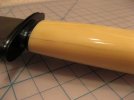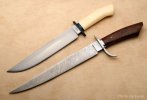you don't store your ivory knife on a cotton cushion do you. if so cotton will draw out the moisture. I see in the pics it looks to be laying on the same shirt, is why I ask.
Actually it is the opposite about storing ivory.
Museums and curators handle ivory with cotton gloves, and store ivory wrapped in acid free paper or in cotton cloth. Diapers are preferred. Placing the cotton wrapped item in a closed plastic tub or a zip-lock bag will keep humidity constant. A fleece or cotton lined zippered knife case, stored in a plastic storage bin with a tight lid, is a good storage method. (Best to use a new pouch. Don't use a pouch that was used to store a knife with an oiled handle previously.)
Cotton will not suck the moisture from things like wood and ivory. It is absorbent for liquids due to the fiber shape, but that is a very different thing from humidity. One of its advantages is that it allows air flow around the object because of the fiber shape.
The biggest thing you don't want to do with ivory is subject it to any soluble color, especially oils. Your dirty hands, blood and body fluids as well as fats from animals being dressed, and other oils the knife is exposed to will stain the ivory easily. I read that people rub baby oil on their ivory every year, etc. I have seen ivory handles with terrible blotches where the baby oil soaked in to a softer dentin part and didn't soak in in the harder enamel areas. Do this at your own risk. I personally just wipe the ivory off with a soft clean cloth barely dampened with clean water, dry it off, and put it away. Also, avoid using any solvents or drying agents on ivory.....acetone, alcohol, naphtha, etc.
All ivory dries with age. That is part of how any organic material acts. Ivory is very dense, and dries extremely slow. The drying can take dozens of years before it gets completely stable.
What will almost guarantee ivory cracking sooner or later is grinding it fast, using dull belts, and getting it hot in buffing. Quality ivory should be shaped with files, hand sanded, and hand buffed.




